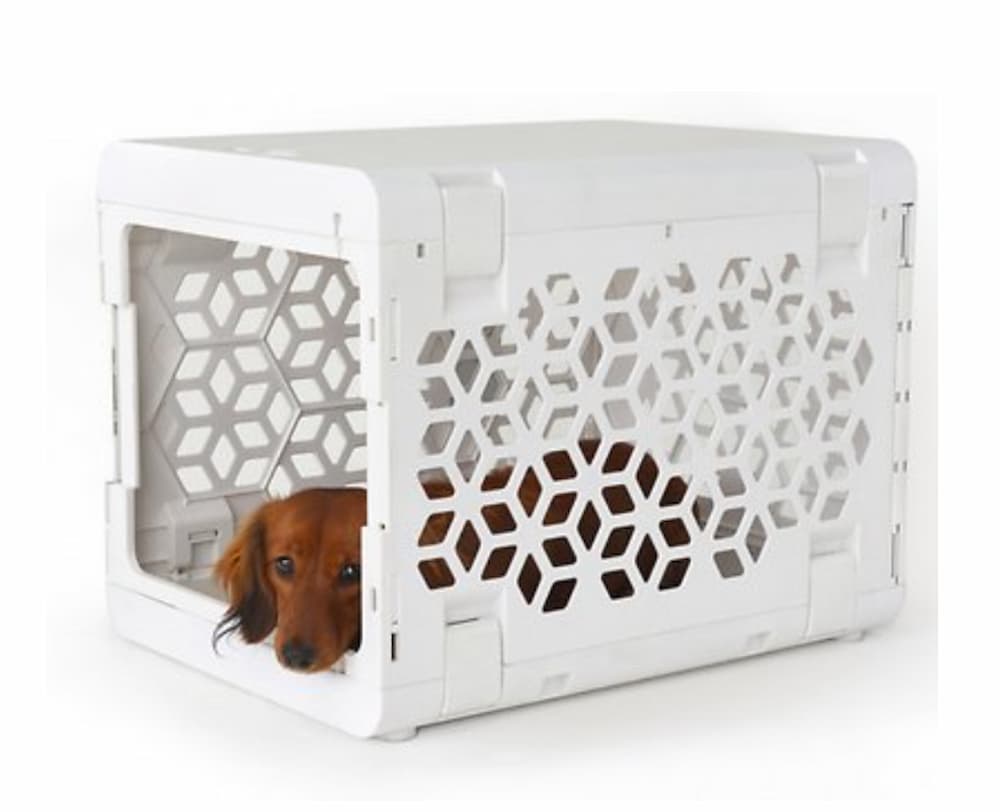How to Crate Train a Fearful Dog in 5 Steps
Updated on May 24, 2024

All featured products are chosen at the discretion of the Vetstreet editorial team and do not reflect a direct endorsement by the author. However, Vetstreet may make a small affiliate commission if you click through and make a purchase.
Q. My dog hates to be in her crate. Do you have any tips for getting her to go inside and stay in the kennel?
A. Crate training can be challenging for dogs who already have negative associations with kennels. The trauma of being left alone in a confined area often outweighs the lure of treats. There may even be a component of separation anxiety tied to their distress.
Step 1: Address Separation Anxiety
Start by talking to your veterinarian about the possibility of separation anxiety. If you have the option, take a video recording of your pet when she’s home alone and show it to your veterinarian. In many cases, canines with separation anxiety do better when they’re not crated.
Once you’ve received guidance from your veterinarian about how to properly address separation anxiety — or rule it out altogether — you can proceed with retraining your pet to go inside the kennel. A vet may recommend a follow-up visit with a certified professional dog trainer.
My father, Dr. Marty Becker, adopted a 3-year-old shelter dog named Quora who had an extreme fear of being crated. In her previous home, she was crated outside for the past two years of her young adult life. She’d hide from my parents to avoid being crated, and then would whine and paw frantically once she was inside. But if she was left outside her crate, she was extremely destructive.
Quora had separation anxiety, in combination with a lack of positive association with her crate. Although many dogs with separation anxiety do not do well crated, Quora eventually took to her kennel through consistent training and medication.
Step 2: Get the Right Crate
It’s helpful to start with a different type of crate than what your pet has used in the past. Quora had been in a hard-sided kennel, so my parents switched to a wire kennel for her retraining — and started the process by leaving the door open. When choosing a wire crate, be sure to pick one with very narrow spaces, so that a dog’s leg cannot push through and cause injury.
For canines who have a fear of confinement, certain types of crates can be built up over time, allowing the animal to get used to the space at their own pace. For example, dogs can be trained to only go into the bottom half of a Vari Kennel. Once they’re comfortable, the top half can be placed onto the crate, followed by the door.
Step 3: Coax With Food and Offer Treats
Begin training your dog to go into the crate by placing her food bowl just outside the crate. With each meal, move the dish farther toward the back of the kennel in gradual increments.
If your pet remains relaxed, you can practice shutting the door once she’s inside the crate, and offer treats through the panels of the crate before immediately reopening it. Eventually, you can close the door for longer periods of time, and give her a stuffed Kong or some other long-lasting chew to distract her.
Step 4: Opt for Heavy Traffic Areas
The crate should also be placed in an area that’s not socially isolated, such as next to you while you watch TV. You can even leave the crate door open and allow your pet to choose whether or not she wants to go inside. As soon as she does go into the kennel, praise her and drop treats into the crate.
You should also deposit treats into the kennel throughout the day, so your pooch ventures inside often to check on goodies. Another trick is to spritz the crate with a pheromone spray that mimics the “at ease” feeling puppies experience when nursing.
Step 5: Keep Confinement in Check
Avoid crating your pet for more than three or four hours at a time, unless it’s overnight. If you plan to be gone for extended periods of time, consider looking into a day care program or a dog walker who can let your pet out of the crate for a break.
Quora’s view of her kennel has gone from a place of fear to one of relaxation. Although not every canine will have the same dramatic transformation, with proper training, many dogs can follow in Quora’s footsteps.





